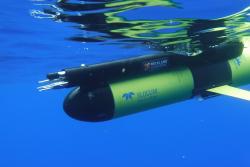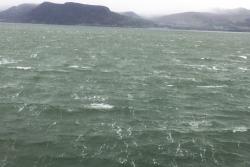Underwater Gliders help improve weather forecasts
 An underwater turbulance glider.: Copyright: Rockland ScientificNew measurements of how waters mix just below the surface of the Atlantic Ocean are to be used to improve weather forecasts.
An underwater turbulance glider.: Copyright: Rockland ScientificNew measurements of how waters mix just below the surface of the Atlantic Ocean are to be used to improve weather forecasts.
The water turbulence was measured by an underwater ‘glider’ and the results of the research, led by �鶹��ý����� researcher Natasha Lucas, are published in a.
Our weather is largely driven by heat supplied to the atmosphere by the ocean. In order to be able to make reliable seasonal predictions of the weather is it vital that the transfer of heat from the ocean to atmosphere is correctly predicted.
A key process in determining this transfer of heat is ‘Langmuir circulation’, or wind rows, which we often see in lakes and the ocean in windy conditions.
Commenting on the work, lead author Natasha Lucas, of �鶹��ý�����’s School of Ocean Sciences says:
“We have known for a while that it is likely that Langmuir processes are important in determining the exchange of heat between the ocean and the atmosphere. However, to accurately represent these processes we needed to be able to make measurements of turbulence close to the ocean surface.
The recent development of underwater gliders from which we can measure turbulence over recent years have enabled us to be able to make the measurements near the surface.
I Wind rows illustrated in this seascape looking towards Penmaenmawrn this new paper we report a series of measurements made in the mid-Atlantic Ocean during an autumn storm. We have then used these measurements to develop a representation of the key processes which will now be put into Met Office weather prediction models to improve seasonal weather forecasts.”
Wind rows illustrated in this seascape looking towards Penmaenmawrn this new paper we report a series of measurements made in the mid-Atlantic Ocean during an autumn storm. We have then used these measurements to develop a representation of the key processes which will now be put into Met Office weather prediction models to improve seasonal weather forecasts.”
Professor Stephen Belcher. Chief Scientist at the Met Office and a co-author on the paper said:
“Getting the interaction between the atmosphere and oceans right is important to all that the met office does, from weather forecasts to climate projections. This work is already being implemented into Met Office forecasts systems, and we should be seeing the benefit soon.”
The paper is a collaboration between physical oceanographers at �鶹��ý����� and the National Oceanography Centre, and meterologists at Reading University and the Met Office, is published in the November edition of the American Meterological Society journal, the Journal of Physical Oceanography.
Publication date: 18 November 2019
